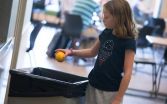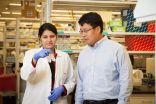The new information, published in The Plant Journal, will not only expand geneticists' knowledge of barley's DNA but will also help in the understanding, at the genetic level, of wheat and other sources of food. It also has applications in plant breeding by increasing the precision of markers for traits such as malting quality or stem rust.
"What we have now is much finer resolution of genetic information throughout the barley genome," said Timothy J. Close, a professor of genetics at UC Riverside and the corresponding author on the research paper. "This is an improved resource used throughout the world. Prior to this work, a long-held view was that the distribution of genes in the genomes of barley, wheat and their relatives is such that the gene-dense regions are only out near the ends of chromosomes where there is also a high rate of recombination. Our work revealed clear exceptions, identifying deviant regions that are gene-rich but low recombination."
Recombination refers to the formation of new combinations of genes naturally during meiosis, which is a stage of the cell cycle where chromosomes pair up and undergo exchange. Close explained that plant breeders rely on meiotic recombination to introduce favorable forms of genes for malting quality, stem rust or any number of traits into cultivated varieties. Crosses are made and progeny plants are screened for desirable new combinations of traits. When a favorable form of a gene (allele) lies within a gene-dense, low recombination region it requires much more work to bring that favorable allele into an existing variety without also dragging in neighboring genes that may exist in undesirable forms.
"For example, a breeder might succeed in adding a favorable allele for stem rust resistance from a wild barley, but along with that gene drag along another gene that causes shattering of the mature head," Close said. "Now the breeder would have a stem rust resistant plant, but the seeds would all fall to the ground rather than remain on the plant until harvest. So, if a gene lies within a gene-dense, low-recombination region, then this means that a much larger number of progeny from crosses must be examined to find those that derive from rare recombinational events that separate the desired new allele from undesirable forms of neighboring genes. Knowing the location of gene-dense low-recombination regions helps with decisions about which genes to pursue for variety improvement."
Close teamed up with Stefano Lonardi, a professor of computer science and engineering at UCR, to develop a set of efficient computational innovations that helped further sequence the barley genome. The new algorithms could handle large datasets, allowing the researchers to gain more progress than would otherwise be possible.
"Tim and I were able to work very closely in all the steps of the project from the experimental design in the wet lab to the final analysis of the results; the major challenge was how to handle the very large number of barley samples and for this we designed a novel approach to sequencing that exploited deep results in combinatorics," Lonardi said.
The work is the outcome of a partnership between the College of Natural and Agricultural Sciences and the Bourns College of Engineering at UCR that has flourished for more than ten years with continuous grant support from the U.S. Department of Agriculture and the National Science Foundation, focused largely on innovations in bioinformatics.
"The partnership has provided an environment in which students, post-docs and others have highly productive experience and training in genomics," Close said.
Key innovations on the computational side are:
the amount of genome sequences the researchers released is about four times the size of the entire rice genome the work took advantage of two very substantial algorithm innovations that Close and Lonardi published with their students in the past year: one a new computational invention to make better use of today's high-volume sequence data; the other a very efficient method of classifying sequences into specific groups the new information has been integrated into a national wheat/barley project (TriticeaeCAP) and has been shared with the International Barley Sequencing Consortium the new information enabled the researchers to clarify aspects of the barley genome that are important in the context of genome evolution and for practical use of genome knowledge by plant breeders and basic researchers--namely, the locations of gene-rich regions including some that have low recombination "When breeders make crosses to develop new varieties, they are seeking new combinations of alleles that are better suited to the agricultural environment or market for the crop product," Close explained. "Often this means making crosses with somewhat distant individuals, which may carry unfavorable alleles at many positions in the genome. When a breeder can cross in only the favorable alleles, then that is beneficial.
"If unfavorable alleles of neighboring genes always are carried in with the favorable alleles of the targeted genes, then that is not useful," he added. "When a favorable allele lies within a region in which recombination seldom breaks the linkage to a bad allele for a neighboring gene, the breeder will have to work much harder with a larger population to find the rare individuals with the right combinations. By pinpointing which regions of the barley genome are resistant to recombination, breeders will be able to make better informed decisions about which favorable alleles to pursue, and to plan more efficiently."
About two decades ago, Close was working nearly exclusively on dehydrins--a family of proteins that all plants make in response to drought stress or low temperature. By 2000, his research group knew that there are at least 13 dehydrin genes in barley, and Close wanted to study them all.
"Genome resources for barley were not adequate, and, fortunately, I had the appropriate type of training to help develop the basic genome resources," he said. "So one thing led to another for me, and for my colleagues at UCR, who became engaged in the barley trek. Now we have completed the last genome resource task that we took on, and there are still a few years left to look again at dehydrin genes of barley.
What Close and his colleagues learned by working with barley has been easy to transfer to cowpea. The research group is now very engaged in cowpea research, which has a 40 year history at UCR.
"We lead an international effort to enhance cowpea breeding efforts, targeting many traits," Close said. "As for barley, the dehydrin genes seem to be very plastic, some of them changing at a high frequency over generations, and we intend to look into this plasticity in more detail now that we have the genome knowledge that we lacked before.
To gain access to the gene-containing portion of the barley genome at high resolution, Close and his team identified and sequenced 15,622 BACs or bacterial artificial chromosomes--small fragments of the barley DNA linked to other DNA to constitute a circular molecule that can replicate and be propagated inside an E. coli bacterial cell, enabling researchers to produce copies of each BAC for DNA sequencing one small piece of the barley genome at a time. Exploring these sequenced BACs that contain an estimated two-thirds of all barley genes, Close and his team found that gene-rich areas are not found only in high combination regions.
"There are gene-rich regions that are in low recombination regions, which is critically important for plant breeding," Close said.
Because barley is a close relative to wheat, the new work could offer useful information leading to the complete sequencing of the wheat genome.
INFORMATION:
Twenty-two of the 49 coauthors on the research paper made contributions while they were at UCR: Maria Munoz-Amatriain, Lonardi, Kavitha Madishetty, Jan T. Svensson, Matthew J. Moscou, Steve Wanamaker, Tao Jiang, Yaqin Ma, Edmundo Rodriguez, Prasanna R. Bhat, Pascal Condamine, Josh Resnik, Matthew Alpert, Marco Beccuti, Serdar Bozdag, Francesca Cordero, Hamid Mirebrahim, Rachid Ounit, Yonghui Wu, Jie Zheng, Denisa Duma, and Close. In addition, most of the raw sequence data were produced at UCR's Genomics Core Facility by John Weger.
The University of California, Riverside (http://www.ucr.edu) is a doctoral research university, a living laboratory for groundbreaking exploration of issues critical to Inland Southern California, the state and communities around the world. Reflecting California's diverse culture, UCR's enrollment has exceeded 21,000 students. The campus opened a medical school in 2013 and has reached the heart of the Coachella Valley by way of the UCR Palm Desert Center. The campus has an annual statewide economic impact of more than $1 billion. A broadcast studio with fiber cable to the AT&T Hollywood hub is available for live or taped interviews. UCR also has ISDN for radio interviews. To learn more, call (951) UCR-NEWS.



